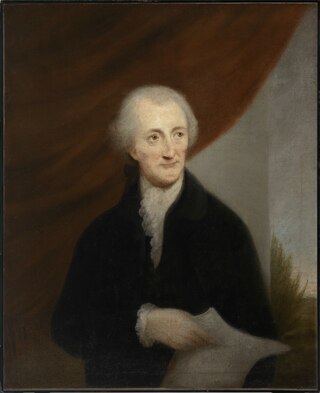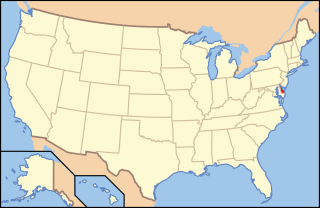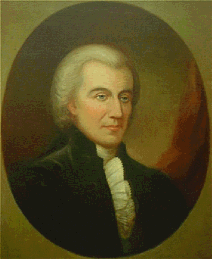Related Research Articles

Thomas McKean was an American lawyer, politician, and Founding Father. During the American Revolution, he was a Delaware delegate to the Continental Congress in Philadelphia, where he signed the Continental Association, the Declaration of Independence, and the Articles of Confederation. McKean served as a President of Congress.

George Read was an American politician from New Castle in New Castle County, Delaware. He was a Continental Congressman from Delaware, a delegate to the U.S. Constitutional Convention of 1787, president of Delaware, and a member of the Federalist Party. In addition, Read served as U.S. Senator from Delaware and chief justice of Delaware.

Caesar Rodney was an American Founding Father, lawyer, and politician from St. Jones Neck in Dover Hundred, Kent County, Delaware. He was an officer of the Delaware militia during the French and Indian War and the American Revolutionary War, a Continental Congressman from Delaware, a signer of the Continental Association and Declaration of Independence, and president of Delaware during most of the American Revolution.

The Delaware Colony, officially known as the three "Lower Counties on the Delaware", was a semiautonomous region of the proprietary Province of Pennsylvania and a de facto British colony in North America. Although not royally sanctioned, Delaware consisted of the three counties on the west bank of the Delaware River Bay.

John Dickinson, a Founding Father of the United States, was an attorney and politician from Philadelphia, Pennsylvania, and Wilmington, Delaware. Dickinson was known as the "Penman of the Revolution" for his twelve Letters from a Farmer in Pennsylvania, published individually in 1767 and 1768, and he also wrote "The Liberty Song" in 1768.

John Morton was an American farmer, surveyor, and jurist from the Province of Pennsylvania and a Founding Father of the United States. As a delegate to the Continental Congress during the American Revolution, he was a signatory to the Continental Association and Declaration of Independence. Morton provided the swing vote that allowed Pennsylvania to vote in favor of the Declaration. Morton chaired the committee that wrote the Articles of Confederation, though he died before signing.
The Delaware Constitution of 1776 was the first governing document for Delaware state government and was in effect from its adoption in September 1776 until its replacement by the 1792 constitution.
A flying camp was a military formation employed by the Continental Army in the second half of 1776, during the American Revolutionary War.

The following is an alphabetical list of articles related to the U.S. state of Delaware.

The following outline is provided as an overview of and topical guide to the U.S. state of Delaware:

The Delaware–William & Mary football rivalry between the Delaware Fightin' Blue Hens and the William & Mary Tribe is a matchup between two public universities, the University of Delaware (UD) and the College of William & Mary (W&M), that are also members of both the Colonial Athletic Association and its legally separate football arm of CAA Football. Both schools have academic reputations that have labeled them as Public Ivies. Both schools are also colonial colleges, having been founded before the United States became independent in 1776; W&M was founded in 1693 and UD's predecessor school was founded in 1743.

The 1792 Delaware gubernatorial election was held on October 2, 1792. It was the first popular election for the state's chief executive; under the 1776 constitution, the President of Delaware was elected by the legislature. Incumbent President Joshua Clayton ran for re-election. He was nominated by the Federalist Party and was opposed by two Anti-Federalists, Thomas Montgomery and George Mitchell. He won re-election by a decisive margin, but fell short of a majority.

The 1858 Delaware gubernatorial election was held on November 2, 1858. Incumbent Know Nothing Governor Peter F. Causey was unable to seek re-election. His 1854 opponent, William Burton, once again ran as the Democratic nominee. James S. Buckmaster, the former State Treasurer, ran as the People's Party candidate. Burton narrowly defeated Buckmaster to win back the governorship for the Democratic Party.

The 1866 Delaware gubernatorial election was held on November 6, 1866. On March 1, 1865, Republican Governor William Cannon died in office, elevating State Senate Speaker Gove Saulsbury, a Democrat, to the governorship. Saulsbury ran for re-election in 1866, the first Governor to do so since Joshua Clayton in 1792. He faced Republican nominee James Riddle, a prominent industrialist. Saulsbury defeated Riddle by a decisive margin, ushering in a large Democratic majority in both houses of the legislature.

The 1870 Delaware gubernatorial election was held on November 8, 1870. Incumbent Democratic Governor Gove Saulsbury was unable to seek re-election. Former State Senator James Ponder ran as the Democratic candidate to succeed Saulsbury and faced Republican nominee Thomas B. Coursey. As Black Delawareans gained the right to vote, Republicans were confident about their chances, and the Democratic Party responded by presenting itself as the "white man's party." Ponder ultimately defeated Coursey by a wide margin, in part because of low Black turnout and a racist backlash against Black suffrage.

The 1874 Delaware gubernatorial election was held on November 3, 1874. Incumbent Democratic Governor James Ponder was unable to seek re-election. Former county judge John P. Cochran ran as the Democratic nominee to succeed Ponder and faced the Republican nominee, Dr. Isaac Jump. Cochran ultimately defeated Jump, but by a significantly reduced margin from 1870.

The 1878 Delaware gubernatorial election was held on November 5, 1878. Incumbent Democratic Governor John P. Cochran was unable to seek re-election. Former State Senator John W. Hall ran as the Democratic nominee to succeed Cochran. The Republican Party, chastened by its long string of defeats, failed to run a statewide candidate. Instead, the Greenback Party stepped in, and Kensey Johns Stewart ran as the Greenback nominee. The absence of the Republican Party on the ballot caused turnout to crash, and Hall defeated Stewart by the largest margin in state history.
This is a list of events in the year 1776 in Delaware.
References
- ↑ Munroe, John A. (2003). "Colonial Delaware: A History" (PDF). Delaware Heritage Press. Retrieved December 22, 2023.